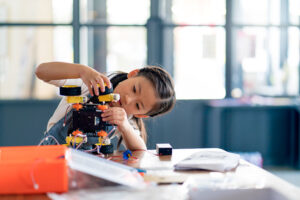5 proven ways to test student learning and knowledge

Unless scientists invent an ingenious space-age brain scan that accurately displays a person’s knowledge, teachers must continue using traditional methods to gauge their students’ understanding.
It’s a critical task, after all, and can be the difference between teaching the right concepts – the concepts that students need to learn – or missing key ideas and creating yawning gaps in their learning. Or if you’re testing the sum of your students’ skills or knowledge for grading purposes, you’ll need to design a rigorous summative assessment to present them with a fair grade. Both are equally important.
These are some of the most effective, time-tested evidence-based methods for assessing your students’ learning, for both formative and summative purposes.
1. Exams
Exams are the classic summative assessment. Usually, students are grouped in a single room or hall, given an online or offline test, and a certain amount of time to complete it. They’re a controversial method, with some educators and observers arguing that they test memory rather than deep, multi-faceted knowledge, and others believing them to be an effective way to measure what students have learned. For us, the worth of an exam comes down to the quality and selection of the questions themselves, which shouldn’t just test memory, but also the students’ range of skills and understanding. The questions can ask for straight facts, but they can also be inferential and require the student to draw logical conclusions, or be posed in a way that guides the student to use their learned skills to answer it correctly. They can also cover a broad, tiered difficulty range which allows all students to answer the easier questions and high-achieving students to tackle the tougher ones.
Exams have another clear benefit: they can make new information easier to learn afterwards; information not covered in the exam itself. This rigorously-researched phenomenon is known as the forward testing effect.1
Many students find exams to be stressful, and this stress can extend to teachers, school leaders, and parents, particularly if the stakes are high. For this reason, they are usually only set when necessary.
2. Assignments
Assignments are tasks such as essays, reports, reviews, or practical work that requires something to be built. They can be set for formative / diagnostic reasons as a way to assess students’ knowledge and hone your lesson plans, or as summative assessments that count towards students’ grades.
When well-designed, assignments can provide clear evidence of learning for students, helping to identify their factual knowledge, their breadth of knowledge, and their depth of knowledge for specific topics or subjects. You may set an essay on why Isaac Newton changed the world, a short book report of The Rainbow Serpent, a painting that illustrates the major causes of climate change, or something else related to the curriculum.
The students’ work will help you to gain a better idea of their knowledge for the topic, and what you may need to focus on to improve their learning outcomes.
3. Academic competitions
When considering ways to test student learning, academic competitions may not spring to mind. Their main purpose is usually to motivate students and give them a chance to shine on an academic level, but if the competition is worth its salt, it may also yield valuable results data that helps you to identify your students’ knowledge gaps (ICAS includes this and more).
Competitions can be considered a low risk high reward type of assessment, giving students the opportunity to compete and win medals in a fun, non-stressful way, with the possibility of providing teachers with rich insights into their students’ understanding.
4. Essays
Essays are a form of assignment, but deserve a mention in their own right. They are usually a short form of writing that encourage students to consider, develop, or expand on arguments or ideas, clearly researched and referenced. Examples may be asking students to perform a critical analysis on democracy versus socialism, an exposition on the Internet, a comparison of mammals and reptiles, or a review of Riding The Black Cockatoo by John Danalis.
Points covered, arguments made, comparisons highlighted, and opinions given are just a few ways for you to gauge a student’s learning (and their learning needs) from their assignment.
5. Self assessments
Self-assessments are a formative method that encourage students to assess their own learning. You may ask them to reflect on their work, “score” it based on success criteria, or identify how they can improve it. This information can be written or spoken, but in either case, it can give you a good understanding of the student’s knowledge of the topic and illuminate which concepts you need to cover in forthcoming classes.
Closely related are peer-assessments, where students constructively critique each other’s work instead of their own, providing valuable insights into what they enjoyed about the work and where improvements can be made. Some students find it easier to assess others’ work rather than their own, so this method can teach them the process and help to ease them into self-assessments.
References
- Bernhard Pastötter and Christian Frings, 2019, The Forward Testing Effect is Reliable and Independent of Learners’ Working Memory Capacity, Journal of Cognition
Tag:Learning



